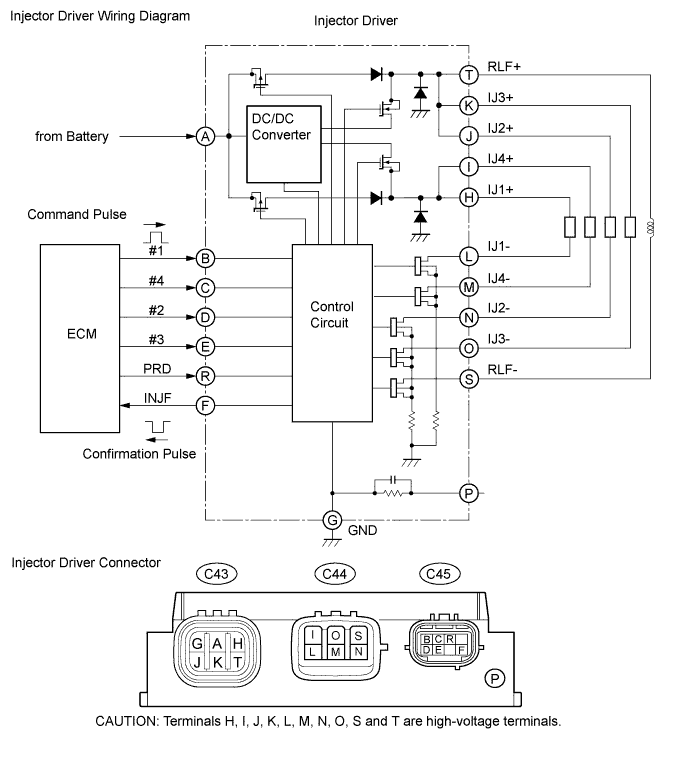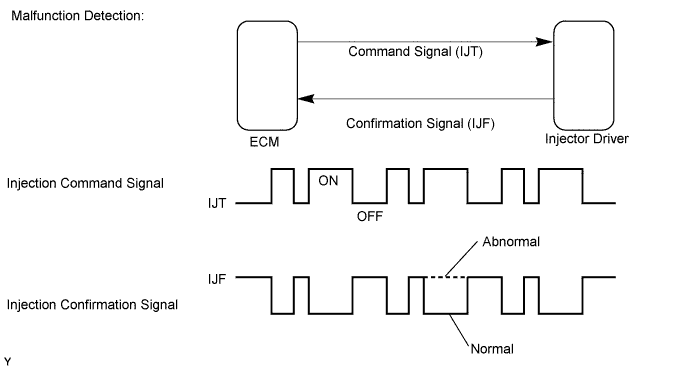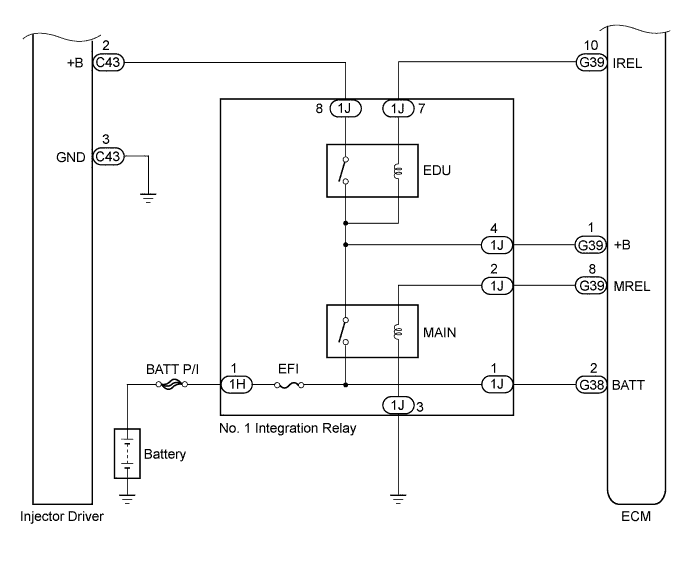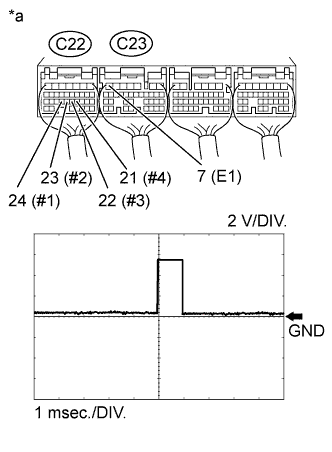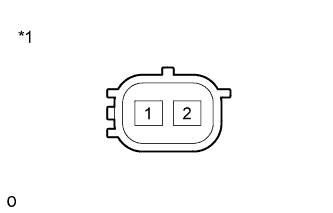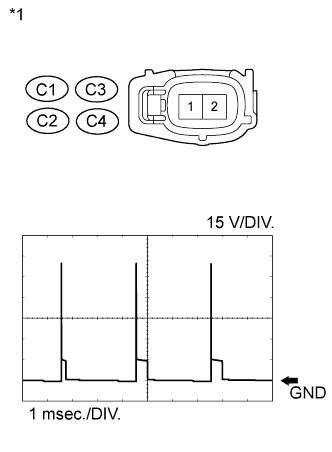DESCRIPTION
MONITOR DESCRIPTION
WIRING DIAGRAM
INSPECTION PROCEDURE
CHECK ENGINE CRANKING CONDITION
CHECK ECM
CHECK TERMINAL VOLTAGE INJECTOR DRIVER POWER SOURCE
CHECK HARNESS AND CONNECTOR (INJECTOR DRIVER - ECM)
REPLACE INJECTOR DRIVER
READ VALUE USING INTELLIGENT TESTER (INJECTION
FEEDBACK VAL #1 to #4)
INSPECT INJECTOR ASSEMBLY (RESISTANCE)
INSPECT INJECTOR DRIVER
REPLACE INJECTOR ASSEMBLY OF MALFUNCTIONING CYLINDER
BLEED AIR FROM FUEL SYSTEM
REGISTER INJECTOR COMPENSATION CODE AND PERFORM PILOT QUANTITY LEARNING
REPLACE ECM
CHECK HARNESS AND CONNECTOR (INJECTOR ASSEMBLY - INJECTOR DRIVER)
REPLACE INJECTOR DRIVER
REPAIR OR REPLACE HARNESS OR CONNECTOR
CONFIRM WHETHER MALFUNCTION HAS BEEN SUCCESSFULLY REPAIRED
DTC P0200 Injector Circuit / Open |
DESCRIPTION
The injector driver delivers drive signals to the injector assemblies using the DC/DC converter, which provides a high-voltage and quick-charging system.Soon after the injector driver receives a fuel injection command (IJT) signal from the ECM, the injector driver responds to the command with an injector injection confirmation (IJF) signal when the current is applied to the injector assembly.P0200DTC Detection Drive Pattern
| DTC Detection Condition
| Trouble Area
|
Idling for 5 seconds
| Open or short in the injector driver or fuel injector circuit (1 trip detection logic).
| - Open or short in injector driver circuit
- Injector assembly
- Injector driver
- ECM
|
MONITOR DESCRIPTION
- P0200 (Open or short in injector driver or fuel injector circuit):
The ECM continuously monitors both injection command (IJT) signals and injection confirmation (IJF) signals. This DTC will be stored if the ECM determines that the number of IJT signals is inconsistent with the number of IJF signals.
The injector assemblies are grounded through a Field Effect Transistor (FET) and a serial resistor. This resistor creates a voltage drop, which is monitored by the injector driver (injector drive circuit) in relation to the current drawn by the injector assembly. When the injector assembly current becomes too high, the voltage drop over the resistor exceeds a specified level and no IJF signal for that cylinder is sent to the ECM.
After the engine is started, when there is no injection confirmation (IJF) signal sent from the injector driver to the ECM even though the ECM sends injection command (IJT) signals to the injector driver, DTC P0200 is stored.
If this DTC is stored, the ECM enters fail-safe mode and limits engine power or stops the engine. The ECM continues operating in fail-safe mode until the ignition switch is turned off.
WIRING DIAGRAM
INSPECTION PROCEDURE
- NOTICE:
- After replacing the ECM, the new ECM needs registration (HILUX_TGN26 RM0000012XK03ZX.html) and initialization (HILUX_TGN26 RM000000TIN04BX.html).
- After replacing an injector assembly, the ECM needs registration (HILUX_TGN26 RM0000012XK03ZX.html).
- HINT:
- When DTC P0200 is stored, the malfunctioning parts can be narrowed down according to fail-safe behavior.
- When a DTC is stored but the engine does not stall, there may be an open circuit or malfunction in the following components which affect the control of individual cylinders.
- The circuit inside an injector assembly.
- The wiring between an injector driver and injector assembly (between terminal IJ1+ and the No. 1 injector assembly, terminal IJ1 and the No. 1 injector assembly, etc.).
- The wiring between an injector driver and the ECM (terminals #10 and #1, etc.).
- When a DTC is stored and the engine stalls, there may be a malfunction in the wiring which affects the control of multiple cylinders.
- Wiring between an injector driver and the ECM (between INJF terminals).
- The power supply wiring.
- Read freeze frame data using the intelligent tester. Freeze frame data records the engine condition when malfunctions are detected. When troubleshooting, freeze frame data can help determine if the vehicle was moving or stationary, if the engine was warmed up or not, and other data from the time the malfunction occurred.
| 1.CHECK ENGINE CRANKING CONDITION |
Check the engine cranking condition.
ResultResult
| Proceed to
|
Engine does not start*1
| A
|
Engine starts, but idling is rough*2
| B
|
Except above
| C
|
- HINT:
- *1: Once DTC P0200 is cleared, it is not stored again even when the engine does not start due to a malfunction in the injector driver (EDU).
When the engine cannot be started due to a malfunction in the injector driver (EDU), the value for "Fuel Press" is higher than the value for "Target Common Rail Pressure"
- *2: DTC P0200 is stored at this time.
Check the waveform of the ECM connectors using an oscilloscope.
Check the waveform of the injector driver (EDU) connectors using an oscilloscope.
- OK:
Tester Connection
| Condition
| Specified Condition
|
C22-24 (#1) - C23-7 (E1)
| Cranking
| Correct waveform is as shown
|
C22-23 (#2) - C23-7 (E1)
| Cranking
| Correct waveform is as shown
|
C22-22 (#3) - C23-7 (E1)
| Cranking
| Correct waveform is as shown
|
C22-21 (#4) - C23-7 (E1)
| Cranking
| Correct waveform is as shown
|
Text in Illustration*1
| Component with harness connected
(ECM)
|
| 3.CHECK TERMINAL VOLTAGE INJECTOR DRIVER POWER SOURCE |
Disconnect the injector driver connectors.
Measure the voltage according to the value(s) in the table below.
- Standard Voltage:
Tester Connection
| Switch Condition
| Specified Condition
|
C43-2 (+B) - C43-3 (GND)
| Ignition switch ON
| 11 to 14 V
|
Text in Illustration*a
| Front view of wire harness connector
(to Injector Driver)
|
Reconnect the injector driver connectors.
| 4.CHECK HARNESS AND CONNECTOR (INJECTOR DRIVER - ECM) |
Disconnect the injector driver connector.
Disconnect the ECM connector.
Measure the resistance according to the value(s) in the table below.
- Standard Resistance:
Tester Connection
| Condition
| Specified Condition
|
C45-4 (#10) - C22-24 (#1)
| Always
| Below 1 Ω
|
C45-8 (#20) - C22-23 (#2)
| Always
| Below 1 Ω
|
C45-7 (#30) - C22-22 (#3)
| Always
| Below 1 Ω
|
C45-3 (#40) - C22-21 (#4)
| Always
| Below 1 Ω
|
C45-5 (INJF) - C22-25 (INJF)
| Always
| Below 1 Ω
|
C45-4 (#10) or C22-24 (#1) - Body ground
| Always
| 10 kΩ or higher
|
C45-8 (#20) or C22-23 (#2) - Body ground
| Always
| 10 kΩ or higher
|
C45-7 (#30) or C22-22 (#3) - Body ground
| Always
| 10 kΩ or higher
|
C45-3 (#40) or C22-21 (#4) - Body ground
| Always
| 10 kΩ or higher
|
C45-5 (INJF) or C22-25 (INJF) - Body ground
| Always
| 10 kΩ or higher
|
Reconnect the injector driver connector.
Reconnect the ECM connector.
| 5.REPLACE INJECTOR DRIVER |
Replace the injector driver (HILUX_TGN26 RM0000046WO00RX.html).
| 6.READ VALUE USING INTELLIGENT TESTER (INJECTION
FEEDBACK VAL #1 to #4) |
Connect the intelligent tester to the DLC3.
Turn the ignition switch to ON and turn the tester on.
Enter the following menus: Powertrain / Engine and ECT / Data List / Injection Feedback Val #1 to #4.
Start the engine.
Read the Injection Feedback Val #1 to #4 values while idling the engine.
- Standard Value:
Item
| Engine Speed*
| Reference Value
|
Injection Feedback Val #1 to #4
| Idling
| +3.0 mm3/st or less
|
- HINT:
- *: The A/C switch and all accessory switches should be off, and the engine should be fully warmed up.
- Fuel is not being injected in cylinders whose "Injection Feedback Val" is higher than 3 mm3/st. Inspection procedures beyond this point diagnose whether there are internal problems with fuel injectors, or whether there is a problem in the wiring of the fuel injector system.
| 7.INSPECT INJECTOR ASSEMBLY (RESISTANCE) |
Disconnect the fuel injector connectors.
Measure the resistance of the fuel injector
- OK:
- No open or short circuit malfunction.
Text in Illustration*1
| Component without harness connected
(Fuel Injector)
|
Reconnect the fuel injector connectors.
| 8.INSPECT INJECTOR DRIVER |
Disconnect the fuel injector connectors for all cylinders.
Check the waveform of the fuel injector connectors using an oscilloscope.
- OK:
Tester Connection
| Condition
| Specified Condition
|
C1-1 - C1-2
| Cranking
| Voltage increases by 50 V or more
|
C2-1 - C2-2
| Cranking
| Voltage increases by 50 V or more
|
C3-1 - C3-2
| Cranking
| Voltage increases by 50 V or more
|
C4-1 - C4-2
| Cranking
| Voltage increases by 50 V or more
|
Text in Illustration*1
| Front view of wire harness connector
(to Fuel Injector)
|
| 9.REPLACE INJECTOR ASSEMBLY OF MALFUNCTIONING CYLINDER |
Replace the injector assembly (HILUX_TGN26 RM000002SY101SX.html).
- NOTICE:
- When replacing the injector assembly for a cylinder, always be sure to use a new injection pipe.
- Follow the procedure in the repair manual and temporarily install the injection pipes and nozzle leakage pipe, and then correctly position the injector assemblies. After that, tighten parts according to the torque specifications.
- If the installation procedure is not performed correctly, injector assemblies may become out of position, which may cause the injector assemblies to deteriorate, resulting in malfunctions.
- If an injector assembly deteriorates and malfunctions, other problems such as knocking, rough idle, etc. may occur.
- If an injector assembly becomes out of position, it is possible that the seal between the injector assembly and injection pipe may become incomplete, resulting in a fuel leak.
| 10.BLEED AIR FROM FUEL SYSTEM |
Bleed the air from the fuel system (HILUX_TGN26 RM000002SY8026X_01_0002.html).
| 11.REGISTER INJECTOR COMPENSATION CODE AND PERFORM PILOT QUANTITY LEARNING |
Register the injector compensation code (HILUX_TGN26 RM0000012XK03ZX_02_0003.html).
Perform the injector pilot quantity learning (HILUX_TGN26 RM0000012XK03ZX_02_0009.html).
Replace the ECM (HILUX_TGN26 RM0000043H100GX.html).
| 13.CHECK HARNESS AND CONNECTOR (INJECTOR ASSEMBLY - INJECTOR DRIVER) |
Disconnect the injector assembly connectors.
Disconnect the injector driver connectors.
Measure the resistance according to the value(s) in the table below.
- Standard Resistance:
Tester Connection
| Condition
| Specified Condition
|
C1-1 - C43-1 (IJ1+)
| Always
| Below 1 Ω
|
C1-2 - C44-6 (IJ1-)
| Always
| Below 1 Ω
|
C2-1 - C43-6 (IJ2+)
| Always
| Below 1 Ω
|
C2-2 - C44-4 (IJ2-)
| Always
| Below 1 Ω
|
C3-1 - C43-5 (IJ3+)
| Always
| Below 1 Ω
|
C3-2 - C44-2 (IJ3-)
| Always
| Below 1 Ω
|
C4-1 - C44-3 (IJ4+)
| Always
| Below 1 Ω
|
C4-2 - C44-5 (IJ4-)
| Always
| Below 1 Ω
|
C1-1 or C43-1 (IJ1+) - Body ground
| Always
| 10 kΩ or higher
|
C1-2 or C44-6 (IJ1-) - Body ground
| Always
| 10 kΩ or higher
|
C2-1 or C43-6 (IJ2+) - Body ground
| Always
| 10 kΩ or higher
|
C2-2 or C44-4 (IJ2-) - Body ground
| Always
| 10 kΩ or higher
|
C3-1 or C43-5 (IJ3+) - Body ground
| Always
| 10 kΩ or higher
|
C3-2 or C44-2 (IJ3-) - Body ground
| Always
| 10 kΩ or higher
|
C4-1 or C44-3 (IJ4+) - Body ground
| Always
| 10 kΩ or higher
|
C4-2 or C44-5 (IJ4-) - Body ground
| Always
| 10 kΩ or higher
|
Reconnect the injector assembly connectors.
Reconnect the injector driver connectors.
| 14.REPLACE INJECTOR DRIVER |
Replace the injector driver (HILUX_TGN26 RM0000046WO00RX.html).
| 15.REPAIR OR REPLACE HARNESS OR CONNECTOR |
Repair or replace the harness or connector.
| 16.CONFIRM WHETHER MALFUNCTION HAS BEEN SUCCESSFULLY REPAIRED |
Connect the intelligent tester to the DLC3.
Clear the DTCs (HILUX_TGN26 RM000000PDK0SWX.html).
Turn the ignition switch off for 30 seconds or more.
Start the engine and idle it for 10 seconds.
Enter the following menus: Powertrain / Engine and ECT / DTC.
Confirm that the DTC is not output again.
